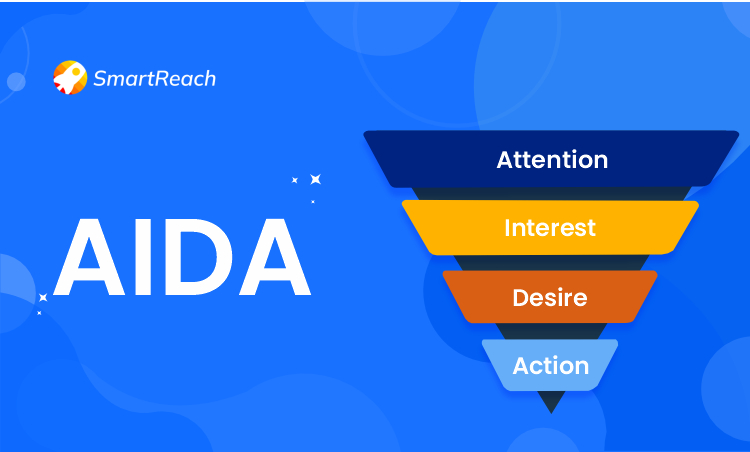AIDA Model
Back to Glossary

In today’s competitive landscape, acquiring and retaining customer attention is more crucial than ever. In such a scenario, the AIDA model is a proven roadmap to guide oblivious strangers to excited paying customers, ultimately boosting your revenue.
According to research, companies that use the AIDA model experience a 26% higher conversion rate compared to those that do not incorporate these principles into their strategies
In this article, we are going to cover the following:
- What is the AIDA Model? Its benefits
- Tactics used in the different stages of AIDA
- Application of the AIDA model
- Drawbacks of the AIDA model
So let’s get started.
What is the AIDA model?
The AIDA Model is like a roadmap for marketing. It breaks down how people typically decide to buy something into four steps: first, they notice it (Attention), then they find it interesting (Interest), next, they really want it (Desire), and finally, they take action and make the purchase (Action)
Companies use the AIDA model to figure out how to create and share messages with their customers at each step of the buying process.
What does AIDA stand for?
The AIDA model is a classic marketing and communications framework that outlines the four stages of a consumer journey for a typical purchase decision.
Here’s how this framework works:
(A)ttention: This is the first stage, where you need to grab the audience’s attention and make them aware of your product, service, or message.
(I)nterest: Once you have their attention, you need to pique their interest and get them to want to learn more.
(D)esire: After generating interest, you need to create a desire for your product or service.
(A)ction: Finally, you need to motivate the audience to take the desired action, which could be making a purchase, subscribing to a newsletter, or attending an event.
Tactics used in different stages of AIDA?
You are already aware of the fdifferent stages of AIDA. In this section we are going to talk about the tactics and techniques used by marketers in each.
Attention
In the initial stage, it is about the point where the focus is on drawing your attention and creating awareness about what is being presented.
The tactics you can use to grab attention are:
- Visuals: Use eye-catching images, videos, or infographics relevant to your audience and message to create a photo that captures attention and conveys your message effectively.
- Headlines: Craft intriguing headlines that ask questions, offer solutions, or use powerful verbs.
- Humor: Inject humor cautiously, ensuring it aligns with your brand and doesn’t offend anyone.
- Trends: Leverage trending topics or current events to grab attention, but avoid being overly opportunistic.
- Personalization: Tailor your message to specific segments of your audience to increase relevance.
Interest
After capturing their attention, it’s crucial to captivate their interest, prompting a desire to delve deeper into what you have to offer.
The tactics you can use to arouse their interest are:
- Benefits: Highlight the key benefits of your product or service, focusing on solving audience problems.
- Problem-solving: Clearly demonstrate how your offering addresses a specific pain point or need.
- Testimonials: Showcase positive feedback from satisfied customers to build trust and credibility.
- Data & Statistics: Use data and statistics to back up your claims and showcase the effectiveness of your offering.
- Storytelling: Use compelling narratives to connect with your audience on an emotional level.
Desire
After generating interest, you need to create a desire for your product or service.
For this, the tactics you can use are:
- Unique Selling Proposition (USP): Emphasize what makes your product or service unique and superior to competitors.
- Comparisons: Compare your offering to competitors, highlighting your strengths and their weaknesses.
- Scarcity & Urgency: Create a sense of exclusivity by offering limited-time deals or limited quantities.
- Personalization: Tailor your message to individual needs and preferences, making your offering feel more desirable.
- Emotional Appeals: Use emotions like excitement, fear, or joy to connect with the audience on a deeper level.
Action
Finally, you need to motivate the audience to take the desired action, which could be making a purchase, subscribing to a newsletter, or attending an event. This is the final stage of removing the barriers in their purchase decision, so you have to be extra careful here.
To make this success, the tactics you can employ are:
- Clear Call to Action (CTA): Use strong, specific CTAs that tell the audience exactly what you want them to do.
- Easy Navigation: Ensure your website or landing page is user-friendly and guides the user towards the desired action.
- Reduce Friction: Eliminate unnecessary steps in the purchase process to make it as smooth as possible.
- Address Objections: Anticipate and address potential concerns or objections to build trust and encourage action.
- Social Proof: Use testimonials, reviews, and trust signals (e.g., security badges) to increase confidence and encourage action.
Benefits of using the AIDA model
The AIDA model offers numerous benefits for businesses by providing a structured framework for creating effective marketing messages and campaigns.
Some of the key advantages are:
Clarity and structure
AIDA model provides a structured and systematic framework for planning and executing marketing campaigns. It helps you organize your efforts and ensures a logical flow in engaging with your target audience.
Understanding customer journey
AIDA breaks down your customer’s journey into different stages, helping you understand how potential customers progress through the decision-making process.
Engagement and retention
AIDA recognizes the importance of capturing attention and sustaining interest. Engaging content at these stages increases the likelihood of retaining your audience’s attention and keeping them interested in your product or service.
Conversion optimization
It helps you craft compelling calls to action and motivate your audience to take the desired steps, whether it’s making a purchase or subscribing to a newsletter.
Measurable results
With the AIDA model, you can set measurable objectives for each stage, making it easier to track and analyze the success of your marketing campaigns. This helps with effective data-driven decisions.
Universal applicability
The AIDA model can be applied to various marketing channels and mediums, including traditional advertising, digital marketing, social media, and content marketing.
Customized messaging
By understanding the different stages of the buying process you can tailor your messaging and communication to resonate with customers at each stage. This ensures content is relevant and addresses their specific needs and concerns.
Streamlined communication
The AIDA model provides a clear roadmap for structuring marketing communication. It ensures messages are logically sequenced, building on each other and leading towards the desired outcome.
While the AIDA model offers several benefits, it is crucial to consider its limitations.
Customer journeys are complex and don’t always follow a linear path. Use the model as a starting point and adapt it based on your specific industry, audience, and campaign goals.
Application of the AIDA model
The AIDA model is applicable across various fields for enhancing customer engagement and achieving desired outcomes in each area. Let’s check some of them:
Marketing
Attention: Use attention-grabbing headlines, visuals, and creative content in your marketing activities to capture your target audience’s attention.
Interest: Craft engaging and informative content that highlights the unique features and benefits of your product or service to sustain interest.
Desire: Showcase success stories, customer testimonials, and exclusive offers to build desire and show the value proposition.
Action: Implement clear and compelling calls-to-action (CTAs) in your marketing communications, encouraging the audience to take the next step, whether it’s making a purchase or signing up for more information.
Sales
Attention: Craft compelling opening statements or pitches to grab your prospect’s attention during initial interactions.
Interest: Provide detailed product demonstrations, address specific needs, and tailor the conversation to sustain your prospect’s interest.
Desire: Emphasize how your product or service meets your prospect’s unique requirements and present case studies or success stories to create a desire for the solution.
Action: Close the sale by guiding your prospect through the purchasing process, overcoming objections, and securing commitment.
Content creation
Attention: Draft eye-catching headlines, thumbnails, or introductions to capture your audience’s attention on different platforms where you showcase your content.
Interest: Create valuable, informative, and engaging content that maintains your audience’s interest and encourages further exploration.
Desire: Showcase the benefits and practical applications of the information, using storytelling and visuals to create a desire for more.
Action: Include clear calls-to-action within the content, guiding your audience to subscribe, share, or take another desired action.
Competitive analysis
Attention: Identify unique selling points and strengths that differentiate your product or service from competitors.
Interest: Provide comparisons and highlight key features to maintain interest in your offering.
Desire: Showcase customer reviews, testimonials, or case studies to build desire for your brand over competitors.
Action: Implement strategic positioning and marketing messages to influence potential customers to choose your product or service.
Client onboarding
Attention: During the onboarding process, provide clear and concise information about what the client can expect.
Interest: Engage clients with informative materials that introduce them to the benefits and features of your services.
Desire: Illustrate how your services can meet the specific needs of the client, fostering a desire for a successful partnership.
Action: Guide clients through the onboarding steps, ensuring a smooth transition and encouraging active participation in the process.
What are the drawbacks of the AIDA model?
Before getting into the limitations of the AIDA model, it’s crucial to recognize that while it has been a fundamental guide in understanding consumer behavior, it comes with its fair share of challenges.
So, let’s explore how evolving customer behaviors and business dynamics challenge its applicability in certain contexts. And see how we can navigate these challenges
Oversimplifying things by making them too straightforward
AIDA explains how people usually think step by step when buying something, but not all purchases happen in this exact order
However, modern buyer behavior is non-linear, involving loops, backtracking, and external influences. Sticking strictly to AIDA might miss crucial touchpoints or cater to an outdated customer behavior pattern.
Limited to first-time buyers
The AIDA model mainly focuses on acquiring new customers. It may not adequately address strategies for retaining existing ones or fostering long-term relationships.
Lack of emotional depth
While AIDA addresses creating desire, it might overlook the powerful role of emotions in decision-making. Connecting with customers on an emotional level can significantly impact their actions.
Challenges in complex sales
For industries with complex sales cycles involving multiple decision-makers or high-value purchases, the AIDA model might fall short. More sophisticated frameworks like MEDDIC might be better suited for in-depth analysis and engagement.
Difficulty Measuring Effectiveness
It can be challenging to directly measure the impact of each AIDA stage on overall campaign success. While website analytics and conversion rates offer insights, consider employing multi-channel attribution models for a more complete picture.
Takeaway on AIDA model
The AIDA model, despite its limitations, remains a valuable framework for understanding customer journeys and crafting impactful marketing campaigns.
By following its principles of capturing attention, igniting interest, fostering desire, and prompting action, you can guide your audience through a logical progression toward your desired outcome.
Remember, that customer behavior is nuanced and rarely linear. Adapt the AIDA model to your specific industry, audience, and goals. Consider the emotional drivers behind decisions, explore non-linear touchpoints, and acknowledge the complexities of long-term customer relationships.
